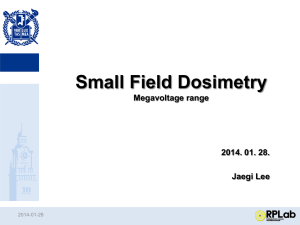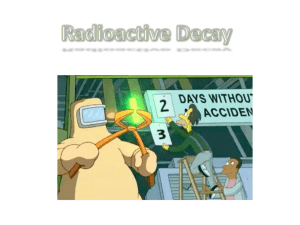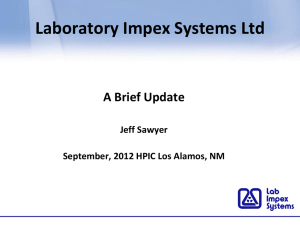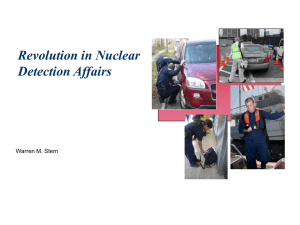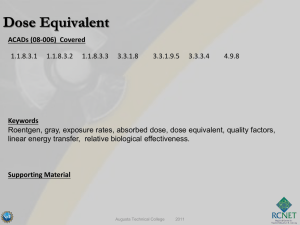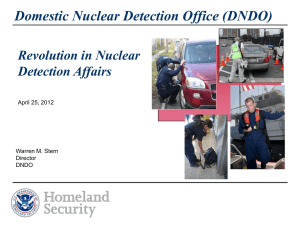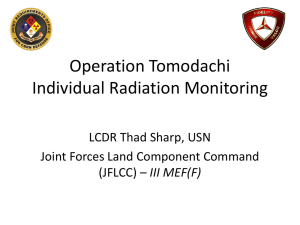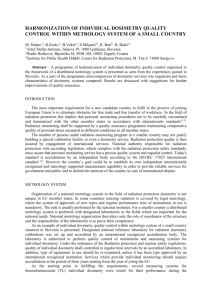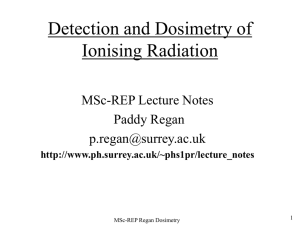here - RAD 2012
advertisement
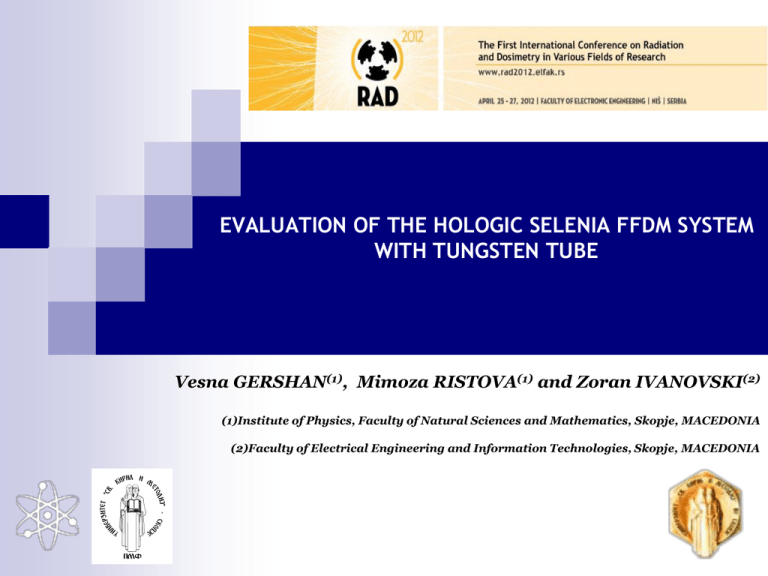
EVALUATION OF THE HOLOGIC SELENIA FFDM SYSTEM WITH TUNGSTEN TUBE Vesna GERSHAN(1), Mimoza RISTOVA(1) and Zoran IVANOVSKI(2) (1)Institute of Physics, Faculty of Natural Sciences and Mathematics, Skopje, MACEDONIA (2)Faculty of Electrical Engineering and Information Technologies, Skopje, MACEDONIA Improvements in FFDM for better image quality - short CsI detector (indirect signal conversion) a-Se detector (direct signal conversion) Improvements in image processing, display performances, etc. Anode targets – Mo, Rh Filters – Mo, Rh The First International Conference on Radiation and Dosimetry in Various Fields of Research (RAD 2012) APRIL 25 – 27, 2012 1. Introduction Several major manufactures of full field digital mammography systems (FFDM) have introduced new models which incorporate X-Ray tubes with tungsten rather than molybdenum anodes; The main motive for using tungsten to reduce the dose to the breast while maintaining the same image quality [1] It was found that for an a-Se detector, the W/Rh target/filter combination is the best choice for all the breast thicknesses and composition and for the detection of both micro calcifications and tumors [2] The first FFDM system with W/Rh and W/Ag combination installed in the Republic of of Macedonia was the HOLOGIC Selenia. This paper presents part of results of evaluation of that system. The First International Conference on Radiation and Dosimetry in Various Fields of Research (RAD 2012) APRIL 25 – 27, 2012 2. Materials and methods (1) Dosimetry parameters measurements were done by Barracauda cabinet (with W/Rh and W/Ag spectra calibration) and Ocean Professional Software; Image quality assessment was done using TOR MAX and CDMAM phantoms; CDMAM was evaluated by CDMAM 3,4 software (ARTINIS) ImageJ software for Pixel Value (PV) determination; MATLAB software for evaluation of Modulation Transfer Function (MTF) CDMAM 3.4 software The First International Conference on Radiation and Dosimetry in Various Fields of Research (RAD 2012) APRIL 25 – 27, 2012 2. Materials and methods (2) 1. Radiation output and beam quality – relationship between delivered tube dose vs mAs and penetrating beam property 2. Detector response function - relationship between detector output variable displayed on the monitor (Pixel Value) and Air Kerma at the image receptor (a-Se detector) (Flat Field Image mode – unprocessed image) 3. Detector uniformity and ghosting – Assessment whether detector flat fielding correction has been correctly applied by the manufacture or the local service; The First International Conference on Radiation and Dosimetry in Various Fields of Research (RAD 2012) APRIL 25 – 27, 2012 2. Materials and methods (3) 4. Automatic Exposure Control (AEC) - adjustment of mAs value according to lowest PV Consistency, Signal to Noise Ratio variation (SNR) and Relative Contrast Noise Ratio (CNR) to 5.0 cm PMMA SNR i PV Al ,i PV backgroud PV i CNR St .dev i i , 5 .0 ,i St .dev i PV Al ( 5 .0 ) PV backgroud St .dev backgroud , 5 .0 , 5 .0 5. Mean Glandular Dose – dose to the glandular tissue in breast MGD K g c s -K is the entrance surface air Kerma (ESAK), -g, c and s are conversion factors for x-ray beam and breast characteristics, - For the W/Rh and W/Ag spectra, a value of 1,042 and 1,063 for the s-factor were used from the recent publication by Dance and Young [4]. The First International Conference on Radiation and Dosimetry in Various Fields of Research (RAD 2012) APRIL 25 – 27, 2012 2. Materials and methods (3) 6. Image quality - contrast detectability Ability to detect objects with different contrast and sizes; Contrast-detail performance of the a-Se detector depends on the detective quantum efficiency (DQE) of the detector 7. Image quality - resolution In DM the major physical factor which affect spatial resolution is the signal blurring in the detector and the integration of the signal over the area of the del; This can be assessed by calculating the MTF from the spread of the signal in the image of a test resolution objects in TOR MAX phantom. The First International Conference on Radiation and Dosimetry in Various Fields of Research (RAD 2012) APRIL 25 – 27, 2012 3. Results 1. Radiation output and beam quality •For W/Rh combination and 28 kV, a radiation output was calculated to be 100.9 Gy/mAs at 50 cm focus –measuring detector distance. •The Half Value Layer (HVL) at 28 kV was determined to be 0.547 mm for W/Rh and 0.600 mm for W/Ag spectra. (higher HVL values than typical Mo/Mo or Mo/Rh mammography spectra) The First International Conference on Radiation and Dosimetry in Various Fields of Research (RAD 2012) APRIL 25 – 27, 2012 3. Results 2. Detector response function It was established that there is a linear dependence of the a-Se detector output variable – PV and the Air Kerma The detector response gradient value, offset and SNR2 linearity (R2) are calculated to be 4.88, 60.99 and 1.0 respectively. For these values, a reference air Kerma of 98.9 Gy was calculated as an average of 548.3 Pixel Values The First International Conference on Radiation and Dosimetry in Various Fields of Research (RAD 2012) APRIL 25 – 27, 2012 3. Results 3. Detector uniformity and ghosting For W/Rh the maximum PV deviation is 1.2% and maximum SNR deviation is 9.3%; While as for W/Ag, the maximum PV deviation is 2.7% and maximum SNR deviation is 7.9%. These findings suggest that the detector flat fielding correction has been correctly applied. The calculated value of the ghost factor was 0.01 (EUREF limit <0.3), which means that there are no residual artifacts at the image from the previous exposure. *According to EUREF protocol, the limitation values are 15% for PV and 10% for SNR deviation. The First International Conference on Radiation and Dosimetry in Various Fields of Research (RAD 2012) APRIL 25 – 27, 2012 3. Results 4. Automatic Exposure Control (AEC) Signal to Noise Ratio variation AEC consistency Set 28 kV, 4 cm PMMA, Dose settings=0, AEC region 2 mAs Avg PV SNR 62.7 512.6 64.5 kV ind. Target /Filter mAs Avg PV SNR 57.0 PMMA (cm) 547.5 59.8 2 25 W/Rh 32.2 514 58.0 65.5 554.1 60.3 3 26 W/Rh 48.7 520 58.3 66.7 561.2 61.1 4 28 W/Rh 64.5 530 58.5 average 64.9 543.8 59.6 5 28 W/Rh 110.9 507 56.9 max deviation 3.3% 5.8% 4.3% 6 30 W/Rh 134.6 503 55.3 < 5.0% 7 28 W/Ag 177.1 547 55.7 average 520.0 57.1 5% 3% EUREF limits max deviation AEC device responds properly The First International Conference on Radiation and Dosimetry in Various Fields of Research (RAD 2012) APRIL 25 – 27, 2012 3. Results 4. Automatic Exposure Control (AEC) Relative CNR to 5.0 cm PMMA PMMA (cm) kV ind. Target /Filter mAs RelativeCNR5.0 EU limits 2 25 W/Rh 32.2 122 >115 3 26 W/Rh 48.7 113 >110 4 28 W/Rh 64.5 105 >105 4.5 28 W/Rh 84.3 104 >103 5 28 W/Rh 110.9 100 >100 6 30 W/Rh 134.6 89 >95* 7 28 W/Ag 177.1 79 >90* *there are doubts about these limits (should be lower) The First International Conference on Radiation and Dosimetry in Various Fields of Research (RAD 2012) APRIL 25 – 27, 2012 3. Results 5. Mean Glandular Dose HOLOGIC Selenia with W tube Due to the higher penetration of the W/Rh and W/Ag spectra, compared to the more common Mo/Mo or Mo/Rh spectra, the calculated MGD was found to be considerably below the European limits. The First International Conference on Radiation and Dosimetry in Various Fields of Research (RAD 2012) APRIL 25 – 27, 2012 3. Results 6. Image quality - Contrast detectability A CDMAM phantom was exposed, using the AUTOFILTER mode and the AEC at a standard dose. (at 30 kV and an average of 84.7 mAs) From the Contrast-detail curve, it was found that the detection rate was 72.8%. (threshold value 62,5%) The First International Conference on Radiation and Dosimetry in Various Fields of Research (RAD 2012) APRIL 25 – 27, 2012 3. Results 7. Image quality - resolution (evaluations of the MTF) The fall of the MTF to 0.5 (50 %) was found to occur at the spatial frequency of 8 lines per mm The highest transmitted spatial frequency is approximately 14 lp/mm The First International Conference on Radiation and Dosimetry in Various Fields of Research (RAD 2012) APRIL 25 – 27, 2012 4. Conclusion By comparing the obtained results with the results from the literature, it can be concluded that the HOLOGIC Selenia system with W/Rh target/filter combination is superior to the systems with Mo/Mo or Mo/Rh combination in terms of ratio image quality/patient dose. The First International Conference on Radiation and Dosimetry in Various Fields of Research (RAD 2012) APRIL 25 – 27, 2012 References 1. J. M. Oduko et al., Effect of using tungsten anode X-Ray tube on dose and image quality in full field digital mammography, 9th International Workshop IWDM 2008, Tucson, USA, Proceedings 2. Bernhardt P, Mertelmeier T, Hoheisel M., X-Ray spectrum optimization of full-digital mammography: simulation and phantom study. Med Phys 2006; 33:4337-49 3. Williams MB, Raghunathan P, More MJ, Seibert JA, Kwan A, Lo JY, et al., Optimization of exposure papameters in full digital mammography, Med Phys 2008; 36:2414-23 4. Dance DR, Thilander Klang A, Sandborg M, Skinner Cl, Castellano Smith IA, Carlsson GA., Influence of anode/filter material and tube potential on contrast, signal-to-noise ratio and average absorbe dose in mammography: a Monte Carlo study, Br j Radiol 2000; 73:1056-67. 5. N W Marshall, Detective quantum efficiency measured as a function of energy for two full-field digital mammography systems, Phys.Med.Biol. 2009, 54, issue 9, 2845-61. 6. H. Fujita, D-Y. Tsai, T. Itoh, K. Doi, IEEE Trans. Med. Imag. 11/1(1992) 34-39. 7. M. Hoheisel, L. Batz, T. Mertelmeier, J. Giersh, A. Korn, Modulation transfer function of a selenium-based digital mammography system, IEEE Nuclear Science Symposium Conference Record 2004, Vol.6, 3589–93. The First International Conference on Radiation and Dosimetry in Various Fields of Research (RAD 2012) APRIL 25 – 27, 2012 Acknowledgment The authors would like to kindly acknowledge to Mile Dukovski from General Private Hospital Remedika, Skopje, R. Macedonia, for the access and the possibility to perform testing of their HOLOGIC Selenia system. Thank you for your attention! The First International Conference on Radiation and Dosimetry in Various Fields of Research (RAD 2012) APRIL 25 – 27, 2012
